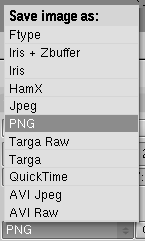Output formats
Relevant to Blender v2.31
The file is saved in whichever format has been selected in the pertinent Menu button in the Format Panel (). From here you can select many image or animation formats (Figure 14).
The default image type is Targa, but, since the image is stored in a buffer and then saved, it is possible to change the image file type after the rendering and before saving using this menu.
By default Blender renders color (RGB) images (bottom line in ) but Black and White (BW) and colour with Alpha Channel (RGBA) are also possible.
Beware that Blender does not automatically add the extension to files, hence any .tga or .png extension must be explicitly written in the File Save window.
Except for the Jpeg format, which yields lossy compression, all the other formats are more or less equivalent. It is generally a bad idea to use Jpeg since it is lossy. It is better to use Targa and then convert it to Jpeg for web publishing purposes, keeping the original Targa.
Anyhow, for what concerns the other formats: TARGA raw is uncompressed Targa, uses a lot of disk space. PNG is Portable Network Graphics, a standard meant to replace old GIF inasmuch as it is lossless, but supports full true colour images. HamX is a self-developed 8 bits RLE (Run Length Encoded bitmap) format; it creates extremely compact files that can be displayed quickly. To be used only for the "Play" option. Iris is the standard SGI format, and Iris + Zbuffer is the same with added Zbuffer info.
Finally Ftype uses an "Ftype" file, to indicate that this file serves as an example for the type of graphics format in which Blender must save images. This method allows you to process 'colour map' formats. The colourmap data is read from the file and used to convert the available 24 or 32 bit graphics. If the option "RGBA" is specified, standard colour number '0' is used as the transparent colour. Blender reads and writes (Amiga) IFF, Targa, (SGI) Iris and CDinteractive (CDi) RLE colormap formats.
For what concerns animations:
AVI Raw - saves an AVI as uncompressed frames. Non-lossy, but huge files.
AVI Jpeg - saves an AVI as a series of Jpeg images. Lossy, smaller files but not as small as you can get with a better compression algorithm. Furthermore the AVI Jpeg format is not read by default by some players.
AVI Codec - saves an AVI compressing it with a codec. Blender automatically gets the list of your available codecs from the operating system and allows you to set its parameters. It is also possible to change it or change its settings, once selected, via the Set Codec button which appears (Figure 15).
For an AVI animation it is also possible to set the frame rate (Figure 15) which, by default, is 25 frames per second.

